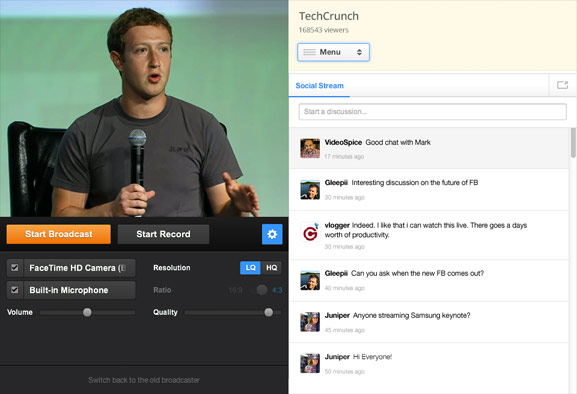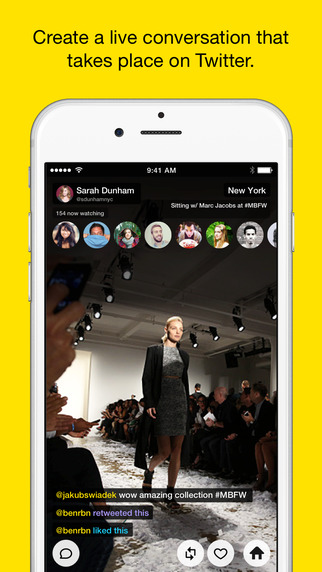One by one, technology has unlocked communication mediums for the masses. Ways of sharing once reserved for those in positions of influence with professional equipment are now open to everyone with a smartphone. What once only a journalist or TV star could do is now a possibility for those who were merely passive consumers.
Each advancement wrestles power away from top-down control of ideas and content that is vulnerable to censorship or sterilization. Each new tool levels the playing field, offering a channel and reach to anyone with something important or entertaining to convey.

The Inevitable Democratization
Over the past 15 years, we’ve seen recorded, asynchronous mediums liberated, followed by near real-time publishing:
- Text publishing: Blogger, then WordPress and Medium
- Photography: Flickr, then Instagram
- Recorded Audio: Podcasting, then SoundCloud
- Recorded Video: YouTube, then Vine and Snapchat
- Near real-time text: Twitter
What’s next?
Live video broadcasting will be the latest step in this inevitable democratization of media.
Now’s The Time
Of course, we’ve been inching in this direction for many years. As far back as 1996, citizens like Marc Scarpa were livestreaming events they thought were important for everyone to see, like the Tibetan Freedom Concert.
On the web, uStream, Livestream, Justin.tv, and Bambuser began making stream broadcasting easy enough for tech novices. Kyte, YouTube Hangouts On Air, and Twitch.tv further refined the idea.

uStream
But mobile changes everything, creating the conditions for true democratization of the medium.
- Portability opens up more compelling content that’s not trapped in a bedroom or studio
- Stronger mobile networks mean people can stream or watch in high-quality on the go
- Better cameras and screens make it all look good.
- Existing social and interest graphs make it quick to build an audience.
It’s time for mobile live video broadcasting. The question is who will deliver it?
Battle For The Broadcast
Meerkat

Meerkat
Two weeks ago, no one was really talking about live video. But two weeks ago, Meerkat didn’t exist. By building a dead-simple broadcasting interface that piggybacks on Twitter‘s interest graph for identity, communication, and distribution, Meerkat made the first mobile livestreaming app that “just works”. You don’t need to build an audience, promote your stream, or keep track of comments. It all happens automatically through Twitter.
Meerkat’s app has a rough-shod charm reminiscent of Snapchat. Bugs make comments glitch out, push notifications fail to open, streams to drop, and videos not to record. Because tweets last forever, but streams can often be short, Meerkat links on Twitter often lead to dead-ends.
Still, Meerkat is succeeding. It’s received rave reviews on Product Hunt, signed up droves of tech’s elite, and seen usage for everything from intellectual discussions to art gallery tours, pets and sunsets to hour-long filibusters I don’t regret.
It might not be the perfect product, but the app is developing invaluable critical mass and network effect. Meerkat has become the proprietary eponym of mobile live video broadcasting. The Kleenex. The Xerox. Anyone else trying to break into the market will do so in Meerkat’s shadow, and have to prove why they’re exponentially better, not just an incremental improvement.
Periscope
That’s the plan for Periscope. Built by the team from mobile education app studio TerribyClever that sold to Blackboard, Periscope is a polished livestreaming app that’s still in stealth. A source with access to a beta version of Periscope told me “it’s way better than Meerkat” and called it “One of the best mobile products I’ve used in a long time”.

A week ago I described Meerkat as “The livestreaming app Twitter should have built”, and suggested Twitter should consider developing in-house or acquiring something like it. The fact is that live broadcast video perfectly aligns with Twitter’s mission “To give everyone the power to create and share ideas and information instantly, without barriers.”
TwitPic was once an outside service trying to democratize photo sharing. When a pilot safely landed a damaged commercial airliner in the Hudson River, a bystander snapped and shared a photo to TwitPic that became world news. Twitter eventually built a native photo sharing feature to capture that impact. Livestreaming is the logical evolution.
So it makes perfect sense that TechCrunch has heard from sources that Twitter is in talks to acquire Periscope, with one source pegging the potential deal at around $100 million. Livestreaming might not be a regular enough behavior that it can thrive as an entire app. But as feature built into Twitter alongside the options to share photos or videos, starting a livestream could instantaneously let us see the world through anyone’s eyes.
We’ll Do It Live
Whether it builds or buys, I’d be quite surprised if Twitter doesn’t jump into this market. It probably won’t be lonely. Older players like Livestream and uStream could kick up their mobile efforts. Major platforms like YouTube could throw resources at their streaming capabilities. Facebook could take a stab at it. Twitch could try to branch out from game commentating.
Snapchat has a one-to-one video streaming feature, but it could move to offer live broadcasts to the growing community of star creators with huge audiences on Snapchat Stories.
But each day, Meerkat gets bigger, stronger, shinier, and more institutionalized. As Facebook discovered with Poke, replicating community is infinitely harder than replication functionality. Competitors such as Periscope (if it stays independent) will need to step up soon before it gains more momentum.
If Twitter offers native livestreaming, that could choke out Meerkat the same way TwitPic was squeezed by own Twitter’s photo hosting. But if that doesn’t happen, or it takes years to get there the way native video did for Twitter, it could be harder to beat back the invasion of the Meerkats.

Photo: Mikhail Koninin
The reason any of this matters is because livestreaming makes information seem urgent and compelling in a way no other medium does. A dense intellectual topic, distant beauty, breaking news, or even banal lifecasting all seem more interesting when you’re watching in real-time.
Will everyone broadcast regularly? No. But that’s fine. Not everyone tweets. Not everyone blogs. Yet people spend hours watching TV and texting with friends. And even if only a fraction of users can gain a wide audience of strangers, you might be happy to get a window into your friends’ lives.
Everyone’s a VIP to someone.
